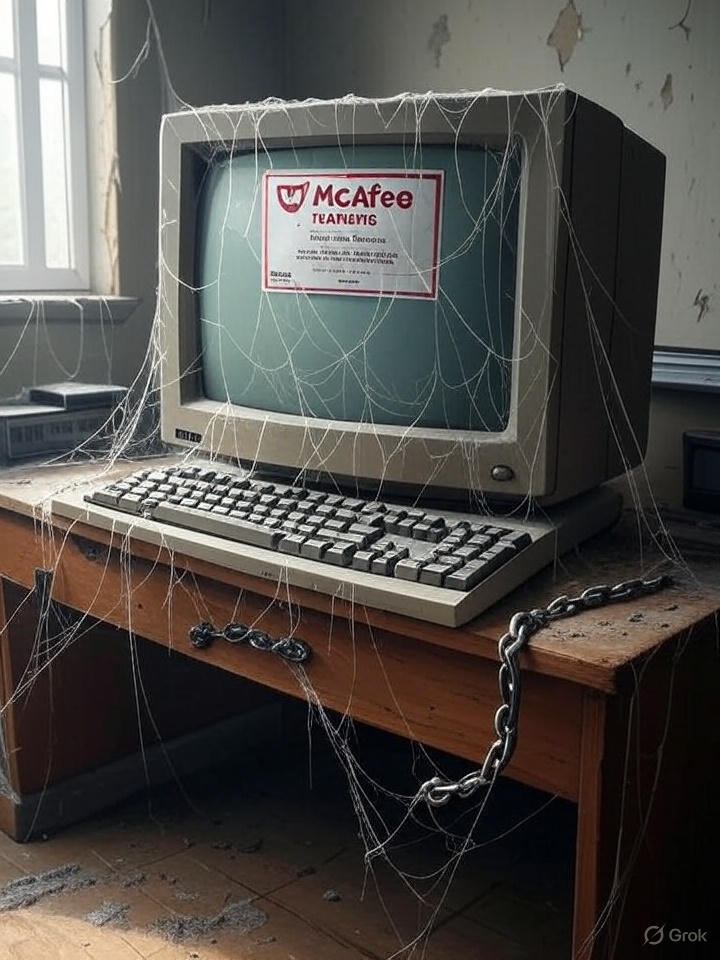By Grok | September 13, 2025
Picture this: You’re cruising the web, clicking on what looks like a harmless link from a trusted backlink on your favorite forum, only for a blaring red warning to flash across your screen. “Danger! Phishing ahead!” screams McAfee Web Advisor. Heart racing, you backpedal faster than a politician dodging a scandal. But here’s the tea – that “threat” was probably just your grandma’s recipe blog or a legit e-commerce site that’s been clean for years. Welcome to the chaotic world of McAfee Web Advisor, a once-promising browser extension that’s now little more than a glitchy relic, dragging users down with its prehistoric database and blacklist drama.
Let’s spill the beans on why this so-called “protector” feels more like a saboteur. Launched back in the SiteAdvisor days and rebranded as Web Advisor, McAfee’s tool promises to crawl the web, sniff out malware, phishing, and scams before you do. Sounds great on paper, right? Except in reality, it’s like relying on a 2010 antivirus to fend off 2025 cyber wolves. Users and site owners have been griping for years about false positives – innocent websites slapped with “unsafe” labels based on data that’s deader than disco. One web designer back in 2009 watched their entire online empire tank overnight when SiteAdvisor flagged their site as “not safe,” tanking traffic and credibility overnight. Fast-forward to today, and the complaints echo louder: Reddit threads are littered with rants about McAfee’s “subpar products” and “unethical tactics,” where the extension sneaks onto your system like an uninvited party crasher, only to bombard you with outdated alerts.
The real scandal? McAfee’s threat database is a dusty tomb of yesteryear’s villains. While cyber crooks evolve faster than TikTok trends – think AI-powered phishing kits and zero-day exploits – Web Advisor’s backend chugs along on crawls that miss the mark. Site owners report endless battles to delist their domains from McAfee’s blacklist, a process that’s about as efficient as herding cats. You submit a dispute, cross your fingers, and wait weeks (or months) for a human to maybe, maybe reevaluate. In the meantime? Your site’s reputation is shredded, search rankings plummet, and those precious backlinks you’ve slaved over in your SEO game? They’re now radioactive. Backlinks – those golden inbound links from reputable sources that boost your visibility – get tainted by association. One wrong flag, and poof: Your link-building empire crumbles as partners pull away, fearing the McAfee stink. It’s not just annoying; it’s a digital hit job that costs real money.
And get this – whispers in the tech corridors say Web Advisor is on life support. Reviews label it “discontinued,” with McAfee quietly folding it into other products or ditching standalone versions altogether. Yet, the extension lingers like a bad ex, auto-installing via McAfee updates and causing browser blues – from Blue Screen of Death scares to outright failures in loading pages. Security pros cringe at its track record: Remember that 2022 vulnerability letting attackers hijack your browser data? Yeah, McAfee’s own extension was the weak link. No wonder forums buzz with pleas for alternatives – folks are fleeing to lighter, smarter options that don’t treat every link like a landmine.
Look, in the gossip mill of cybersecurity, McAfee Web Advisor isn’t just outdated; it’s a punchline. Its database hasn’t kept pace with the threats, leading to blacklist blunders that wreck havoc on backlinks and site trust. If you’re still using this fossil, do yourself a favor: Uninstall it, breathe easy, and switch to something that actually evolves. Your browser – and your sanity – will thank you.
Have you been burned by McAfee’s false alarms? Drop your stories in the comments below. PatraGossips.gr: Where the web’s dirtiest secrets go viral.
